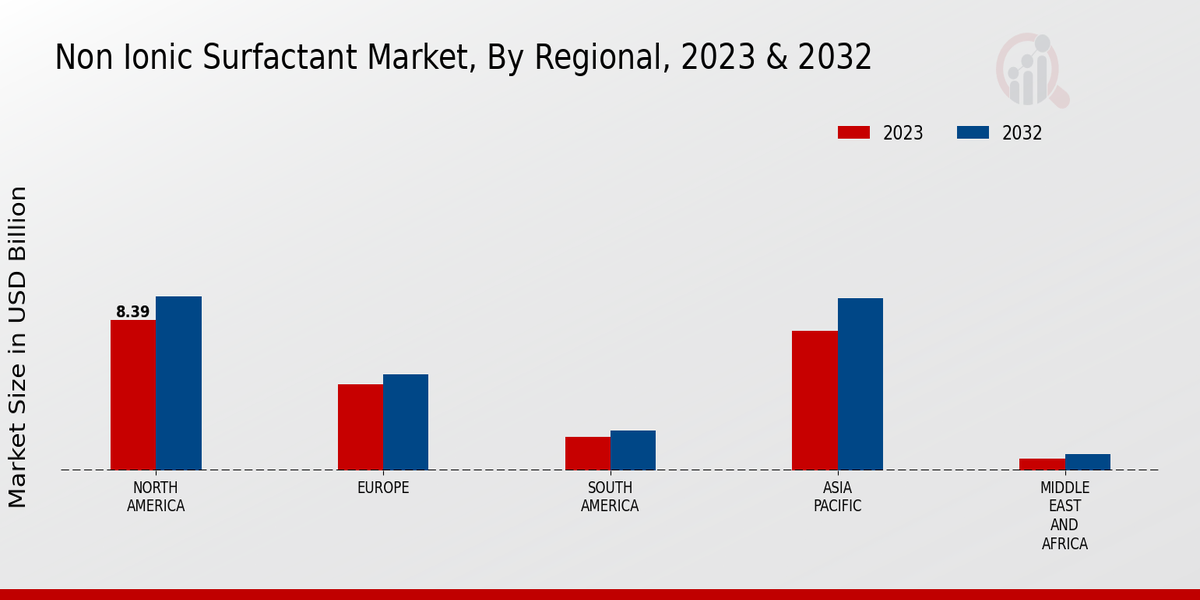Market Growth Projections
The Global Non-Ionic Surfactant Market Industry is projected to experience steady growth over the coming years. The market is expected to reach a value of 24.4 USD Billion in 2024 and is anticipated to grow to 29.8 USD Billion by 2035. This growth trajectory indicates a compound annual growth rate (CAGR) of 1.86% from 2025 to 2035. Such projections reflect the increasing adoption of non-ionic surfactants across diverse applications, including household cleaning, personal care, and industrial sectors. The sustained demand for these surfactants is likely to drive innovation and expansion within the industry.
Rising Industrial Applications
The Global Non-Ionic Surfactant Market Industry benefits from the rising demand for non-ionic surfactants in various industrial applications, including textiles, agriculture, and oil recovery. In the textile industry, these surfactants are employed for their wetting and emulsifying properties, enhancing dyeing processes. In agriculture, they serve as adjuvants, improving the efficacy of pesticides and herbicides. The oil recovery sector also utilizes non-ionic surfactants to enhance oil extraction processes. This diverse applicability across industries is likely to bolster the market, contributing to a projected CAGR of 1.86% from 2025 to 2035.
Expansion in Personal Care Applications
The Global Non-Ionic Surfactant Market Industry is witnessing significant growth due to the expanding applications in personal care products. Non-ionic surfactants are utilized in shampoos, conditioners, and skin care formulations for their ability to enhance texture and improve product stability. The increasing consumer awareness regarding personal grooming and hygiene is propelling the demand for high-quality personal care items. As a result, manufacturers are increasingly incorporating non-ionic surfactants into their formulations to meet consumer expectations. This trend is anticipated to sustain the market's growth trajectory, with projections indicating a market value of 29.8 USD Billion by 2035.
Technological Advancements in Production
The Global Non-Ionic Surfactant Market Industry is influenced by ongoing technological advancements in the production processes of non-ionic surfactants. Innovations in manufacturing techniques are leading to improved efficiency and reduced production costs, making these surfactants more accessible to a broader range of applications. Enhanced production methods also contribute to the development of more sustainable and environmentally friendly surfactants. As manufacturers adopt these advanced technologies, the market is expected to benefit from increased supply and reduced prices, further driving growth in various sectors, including cleaning and personal care.
Regulatory Support for Sustainable Products
The Global Non-Ionic Surfactant Market Industry is positively impacted by regulatory support aimed at promoting sustainable and environmentally friendly products. Governments worldwide are implementing stricter regulations on the use of harmful chemicals in consumer products, encouraging manufacturers to adopt non-ionic surfactants, which are generally regarded as safer alternatives. This regulatory landscape fosters innovation and investment in the development of sustainable surfactant formulations. As companies align their product offerings with these regulations, the market is likely to see increased demand, further solidifying the role of non-ionic surfactants in various applications.
Growing Demand in Household Cleaning Products
The Global Non-Ionic Surfactant Market Industry experiences a notable surge in demand driven by the increasing consumer preference for eco-friendly and effective household cleaning products. Non-ionic surfactants are favored for their mildness and compatibility with various formulations, making them ideal for use in detergents and surface cleaners. As consumers become more environmentally conscious, manufacturers are reformulating products to include non-ionic surfactants, which are biodegradable and less harmful to aquatic life. This trend is projected to contribute to the market's growth, with the industry expected to reach 24.4 USD Billion in 2024.
















Leave a Comment